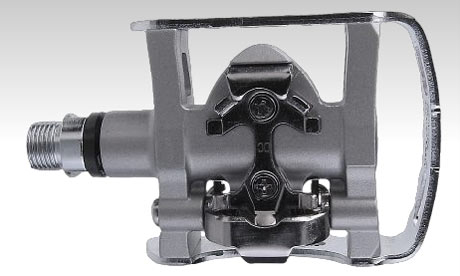
Next time you're in the office and a newly arrived cycling colleague walks past making a faint click-clack noise as they go, they've either mistakenly put on their tap shoes or – a better bet – they are among the many devotees of the cleat, or clip-in pedal.
It is now 20 years since the Shimano SPD, the pedal that took the technology from the world of road racing to mountain biking and then on to the everyday commute, was launched to the world.
Officially, it didn't enter the Japanese company's range of mountain bike gear till 1990, but some bloggers recall spotting preview versions of the chunky original SPDs (short for Shimano Pedalling Dynamics) in late 1989, and that's good enough for me.
Now I'm not about to get into the many for-and-against arguments for clip-in pedals, which are supposed to get more energy out of each leg rotation and make you faster and more powerful up hills. Not everyone takes to them and that's just fine.
But if you're a fan, take a moment to appreciate the advance that the SPD represented. As this rather wonderful clip-in pedal timeline shows, the modern binding had by the time of its arrival been around for almost two decades, beginning with a square-shaped metal device created for track use by the Italian company Cinelli. Officially known as the M71 it was sometimes known as the "death cleat" as there was no automatic release – to get your foot out you had to bend over and move a manual lever.
And while the technology evolved – by 1995 Bernard Hinault won the Tour de France using the soon-to-be ubiquitous pedals made by the French company Look – the plastic shoe cleats which clipped into the pedal bulged out from the toes so much that walking more than the few yards to your bike was a tricky business, like wearing high heels in reverse.
Not only was the relatively tiny SPD cleat recessed into the shoe sole, making walking a breeze, but the pedals were double-sided and easy to engage. It's thus little surprise that as the years went on, the technology moved from mountain bikers to everyday riders. I'd say maybe a quarter of the commuters I see in London use SPD-type pedals these days.
Of course, there's now a series of alternatives to the SPD, but even after dabbling with some rivals I still reckon they're the best. Yes, they can get clogged with mud if you're off road, but particularly for commuting their mixture of adjustability (you can change how tightly the pedal grips the cleat) and sheer reliability is unbeatable.
In certain, more snobbish cycling circles it can be fashionable to denigrate Shimano gear, in part for its ubiquity, but let's raise a glass to the SPD.







